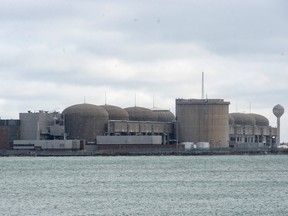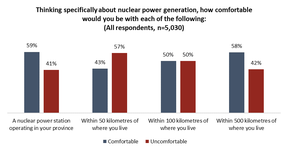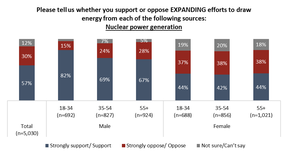More than half of Canadians want more nuclear plants, and more than a third wouldn't mind one in their neighbourhood
David Suzuki dubbed nuclear a distraction from solar and wind technology, writing “pursuing nuclear at the expense of renewables is costly, dangerous and unnecessary.”
Author of the article: Tristin Hopper

After Russia’s Feb. 24 invasion of Ukraine, Ottawa has even suggested that exported Canadian reactor technology could be used to wean Europe off its dependence on Russian oil and gas. “Nuclear energy must be part of such a sustainable future. And Canada is here to help make that happen,” natural resources minister Jonathan Wilkinson said in October at a Washington, D.C., conference of the International Atomic Energy Agency.
Although international polls have shown mixed support for nuclear energy as recently as 2020, many of those fears have been cast aside amid the current global energy crunch.
Japan instantly shut down almost its entire nuclear sector after the 2011 ccident at its Fukushima Daiichi Nuclear Power Plant. Now, the country is scrambling the reactivation of as many as nine reactors to help cover for a sudden drop in Russian gas imports.
Germany had originally planned to complete a total phaseout of its nuclear power sector in 2022. But there, too, the sudden disappearance of Russian energy supplies forced German Chancellor Olaf Scholz to order the country’s three remaining nuclear plants to stay open.
In Canada, the shift towards nuclear seems to be similarly motivated largely by practicality. With climate policies increasingly driving fossil fuel plants into obsolescence, nuclear has been pitched as a relatively shovel-ready workaround. While jurisdictions such as B.C. and Quebec can safely source almost all their electricity from hydroelectric power, in large swaths of the country renewables are still not a realistic replacement for the baseload power currently provided by diesel or natural gas.
In Nunavut, for instance, virtually all electricity generation is generated by diesel imported into the territory by tanker during the ice-free summer months. As of last count, both Saskatchewan and Alberta are still relying on coal for more than a third of their power generation.
In a 2021 poll, Saskatchewanians were found to be widely supportive of using nuclear to phase out coal and oil. Wrote pollsters: “public support for the use of (small modular reactors) in Saskatchewan is much greater than opposition, with strong positive opinion outweighing strong negative opinion by a factor of three.”

Author of the article: Tristin Hopper

The Pickering Nuclear Generating Station. According to an Angus Reid Institute poll, most Canadians want more of these.
PHOTO BY THE CANADIAN PRESS/FRANK GUNN
First Reading is a daily newsletter keeping you posted on the travails of Canadian politicos, all curated by the National Post’s own Tristin Hopper
Although nuclear power continues to be resolutely opposed by much of the mainstream Canadian green movement, a series of illuminating new polls by the Angus Reid Institute show that Canadians are increasingly comfortable with an atomic future.
Fifty-seven per cent of Canadians now support “further development” of nuclear power plants, and a not-insubstantial number are even fine with that nuclear plant being built in their own city. Of respondents, 43 per cent said they were comfortable with a nuclear generating station being constructed within 50 kilometres of their home.
“As the world pushes towards net-zero emissions targets, and away from the war-influenced roller coaster of fossil fuel prices, many countries — including Canada — are putting the nuclear option back on the table,” wrote the Institute in a statement.

First Reading is a daily newsletter keeping you posted on the travails of Canadian politicos, all curated by the National Post’s own Tristin Hopper
Although nuclear power continues to be resolutely opposed by much of the mainstream Canadian green movement, a series of illuminating new polls by the Angus Reid Institute show that Canadians are increasingly comfortable with an atomic future.
Fifty-seven per cent of Canadians now support “further development” of nuclear power plants, and a not-insubstantial number are even fine with that nuclear plant being built in their own city. Of respondents, 43 per cent said they were comfortable with a nuclear generating station being constructed within 50 kilometres of their home.
“As the world pushes towards net-zero emissions targets, and away from the war-influenced roller coaster of fossil fuel prices, many countries — including Canada — are putting the nuclear option back on the table,” wrote the Institute in a statement.

The poll also revealed a weird gender gap in nuclear opinions that has been showing up pretty consistently since the 1970s. Basically, men love nuclear while women hate it. The above chart shows near-universal support for nuclear power among male Canadians under the age of 34, while only 44 per cent of women in the same age group were similarly enthusiastic for the technology.
PHOTO BY ANGUS REID INSTITUTE
Opinions on nuclear energy have already begun to shift at the federal level. In recent years, the Trudeau government has begun openly talking up nuclear energy as a viable means to kick fossil fuels.
The most recent federal budget included $120.6 million for Canada to start figuring out a way to pepper the country with “small modular reactors.”
Dubbing the technology a “promising pathway to support Canada’s low-carbon energy transition,” the budget hinted that house-sized nuclear reactors could eventually be keeping the lights on everywhere from remote work camps to rural corners of New Brunswick.
Opinions on nuclear energy have already begun to shift at the federal level. In recent years, the Trudeau government has begun openly talking up nuclear energy as a viable means to kick fossil fuels.
The most recent federal budget included $120.6 million for Canada to start figuring out a way to pepper the country with “small modular reactors.”
Dubbing the technology a “promising pathway to support Canada’s low-carbon energy transition,” the budget hinted that house-sized nuclear reactors could eventually be keeping the lights on everywhere from remote work camps to rural corners of New Brunswick.
After Russia’s Feb. 24 invasion of Ukraine, Ottawa has even suggested that exported Canadian reactor technology could be used to wean Europe off its dependence on Russian oil and gas. “Nuclear energy must be part of such a sustainable future. And Canada is here to help make that happen,” natural resources minister Jonathan Wilkinson said in October at a Washington, D.C., conference of the International Atomic Energy Agency.
Although international polls have shown mixed support for nuclear energy as recently as 2020, many of those fears have been cast aside amid the current global energy crunch.
Japan instantly shut down almost its entire nuclear sector after the 2011 ccident at its Fukushima Daiichi Nuclear Power Plant. Now, the country is scrambling the reactivation of as many as nine reactors to help cover for a sudden drop in Russian gas imports.
Germany had originally planned to complete a total phaseout of its nuclear power sector in 2022. But there, too, the sudden disappearance of Russian energy supplies forced German Chancellor Olaf Scholz to order the country’s three remaining nuclear plants to stay open.
In Canada, the shift towards nuclear seems to be similarly motivated largely by practicality. With climate policies increasingly driving fossil fuel plants into obsolescence, nuclear has been pitched as a relatively shovel-ready workaround. While jurisdictions such as B.C. and Quebec can safely source almost all their electricity from hydroelectric power, in large swaths of the country renewables are still not a realistic replacement for the baseload power currently provided by diesel or natural gas.
In Nunavut, for instance, virtually all electricity generation is generated by diesel imported into the territory by tanker during the ice-free summer months. As of last count, both Saskatchewan and Alberta are still relying on coal for more than a third of their power generation.
In a 2021 poll, Saskatchewanians were found to be widely supportive of using nuclear to phase out coal and oil. Wrote pollsters: “public support for the use of (small modular reactors) in Saskatchewan is much greater than opposition, with strong positive opinion outweighing strong negative opinion by a factor of three.”

The majority Canadians still don’t want a nuclear plant within 50 kilometres of their house, but Canada routinely elects majority governments with levels of support well below 42 per cent.
PHOTO BY ANGUS REID INSTITUTE
Overhanging all of this, meanwhile, is the raw fact that Canada is going to need a massive expansion of new electricity sources if it holds fast to sweeping national promises to electrify cars, industry and home heating. By 2050, the Canadian Energy Regulator has forecast that electricity demand could be as much as 85 per cent higher than what it was in 2019.
While there is a rising pro-nuclear faction within the Canadian green movement, the technology remains opposed by many of the usual standard-bearers for environmental causes. The Green Party of Canada continues to oppose all nuclear energy, calling it “dangerous and dirty.”
In a 2021 post to his foundation’s website, environmentalist David Suzuki dubbed nuclear a distraction from solar and wind technology, writing “pursuing nuclear at the expense of renewables is costly, dangerous and unnecessary.”
Overhanging all of this, meanwhile, is the raw fact that Canada is going to need a massive expansion of new electricity sources if it holds fast to sweeping national promises to electrify cars, industry and home heating. By 2050, the Canadian Energy Regulator has forecast that electricity demand could be as much as 85 per cent higher than what it was in 2019.
While there is a rising pro-nuclear faction within the Canadian green movement, the technology remains opposed by many of the usual standard-bearers for environmental causes. The Green Party of Canada continues to oppose all nuclear energy, calling it “dangerous and dirty.”
In a 2021 post to his foundation’s website, environmentalist David Suzuki dubbed nuclear a distraction from solar and wind technology, writing “pursuing nuclear at the expense of renewables is costly, dangerous and unnecessary.”
Published Jan 13, 2023 •
No comments:
Post a Comment